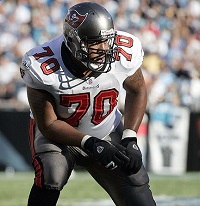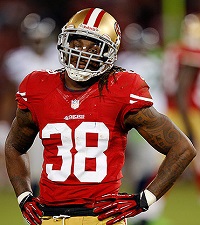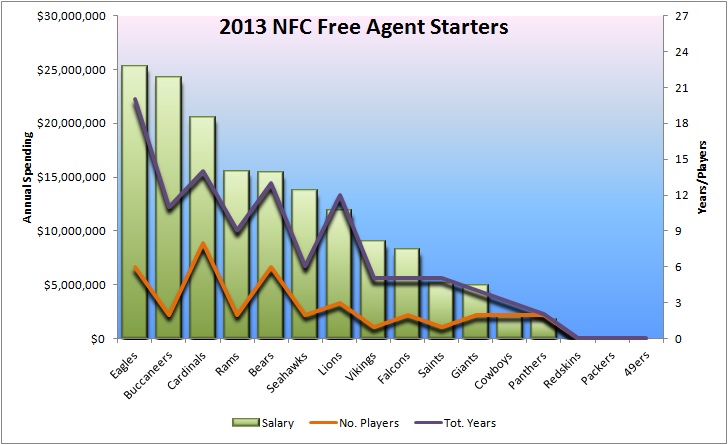[adsenseyu1]
A few weeks ago Jason LaCanfora published a list of best and worst contracts in the NFL so I thought it might make a good idea for us to do the same here at OTC, with a team by team approach. I’ll try to be a bit more analytical in terms of why money was paid and how it fits in the market, but the general premise is the same. The one key difference is outside of restructured rookie contracts under the old CBA we will only use veteran contracts as there is a big difference between best draft picks and best contracts. Please note that there is a difference between a bad player and a bad contract when discussing some of the selections. Clicking on a players name will take you to his salary cap page.
 Best Contract: Donald Penn
Best Contract: Donald Penn
Penn never misses a game and is a steady player who made good, but by no means great, money at a time when Left Tackles had exploding salaries. Penn was a restricted free agent in 2010 which put him in a negative position when trying to negotiate a contract. The Buccaneers could have forced Penn to play the year at slight above $3 million and then let him re-enter free agency in 2011. Instead they signed him to a contract that gave Penn some protection and the Buccaneers favorable terms over the life of the contract.
Penn would not receive top level money and would be required to play at a very high level to bring his average to that of some of the better players at the position, with incentives tied to Pro Bowl nominations. Only $6.5 million of Penn’s new contract was fully guaranteed, $2 million of which came in the form of a signing bonus, giving the Buccaneers an easy escape if his play declined. In return for the lower APY and guarantees Penn would receive a guaranteed $6.5 million in 2010, more than doubling his salary for the year, and another non-guaranteed $7.6 million in 2011. He also received injury guarantees for the 2011 and 2012 seasons.
Tampa Bay tied $600,000 per season to weight based incentives and also included $400,000 per year in workout money to ensure that he participates in the teams’ offseason workout and conditioning programs. With no real guarantees and only $333,333 in prorated money each year, Penn has to keep up a solid level of play to maintain his spot on the team. The team was able to also receive favorable terms in the middle portion of the contract with cap charges never exceeding $6.4 million dollars. He can earn pay raises at the end of his contract, at which point the cost to cut him would be less then $1 million making those raises more or less worthless as he would be released prior to any raises kicking in.
 Worst Contract: Dashon Goldson
Worst Contract: Dashon Goldson
The way the Buccaneers structure their contracts makes it difficult to find a bad contract in terms of longevity. Since most of their deals contain no prorated money you really can only examine the frontend of the contract to try to best determine how good or how bad the contract is. One of the negative features of the contract philosophy is that the Buccaneers are often overpaying for players. Almost every one of their big free agent signings over the last two seasons you can make an argument are overpaid and receive contracts with higher guarantees than better players. The philosophy also can turn deals from passable to bad with the stroke of a pen when cap relief is needed and prorated money is added to the contract, as they did with Vincent Jackson and Carl Nicks at the end of last season.
I think a strong case can be made that Nicks is the worst contract on the team following the restructure because it now is the worst of both worlds- overpaid plus a contractual structure that gives added layers of protection to the player- but I think Goldson stands out even moreso than Nicks because of the talent level. Nicks is a legit exceptional player. Goldson is more of a reputation player. That doesn’t make him bad by any stretch but he is someone that was aided greatly by the defense he played on.
Looking at the top end of the Safety market Goldson does not compare to players like Eric Weddle yet he is essentially making the same type of money. His first two years are completely guaranteed and his $9 million dollar cap charges these next two seasons are going to rank in the top 5 both seasons, figures that should be too high based on what he will give the team. I’m not sure if many people realize that Goldson will be 29 this year. Weddle was 26 when he signed his extension. Kam Chancellor will only be 25 this season. Jairus Byrd is 27. Antrel Rolle was 28 in his season of signing. It is a significantly higher risk to guarantee the type of money that the Buccaneers guaranteed to Goldson. The real comparable to Goldson is someone like LaRon Landry who earned $6 million a year with $11 million guaranteed on a deal most thought was overpayment for the 29 year old Safety.
The more worrisome aspect will be if they decide that they need more cap room and go to him for relief as he and CB Darrelle Revis would be the logical candidates for cap relief as they look to get the funds to sign or re-sign a Quarterback. That would have the potential to make his contract a real problem in the future with more cap charges in excess of $9 million a season. Unfortunately because of the high guarantees in 2013 and 2014, plus an injury guarantee in 2015, they have little wiggle room if they need cap relief for another spending spree next offseason. Currently the Buccaneers are projected to be a few million under the 2014 salary cap, a projection that does not include a QB salary making Goldson a likely restructure candidate.
Check out Our Other Best & Worst Contract Articles
AFC East: Buffalo Bills, Miami Dolphins, New England Patriots, New York Jets
AFC North: Baltimore Ravens, Cincinnati Bengals, Cleveland Browns, Pittsburgh Steelers
AFC South: Houston Texans, Indianapolis Colts, Jacksonville Jaguars, Tennessee Titans
AFC West: Denver Broncos, Kansas City Chiefs, Oakland Raiders, San Diego Chargers
NFC East: Dallas Cowboys, New York Giants, Philadelphia Eagles, Washington Redskins
NFC North: Chicago Bears, Detroit Lions, Green Bay Packers, Minnesota Vikings
NFC South: Atlanta Falcons, Carolina Panthers, New Orleans Saints, Tampa Bay Buccaneers
NFC West: Arizona Cardinals(July 29)
[subscribe2]


